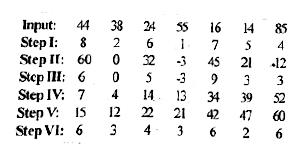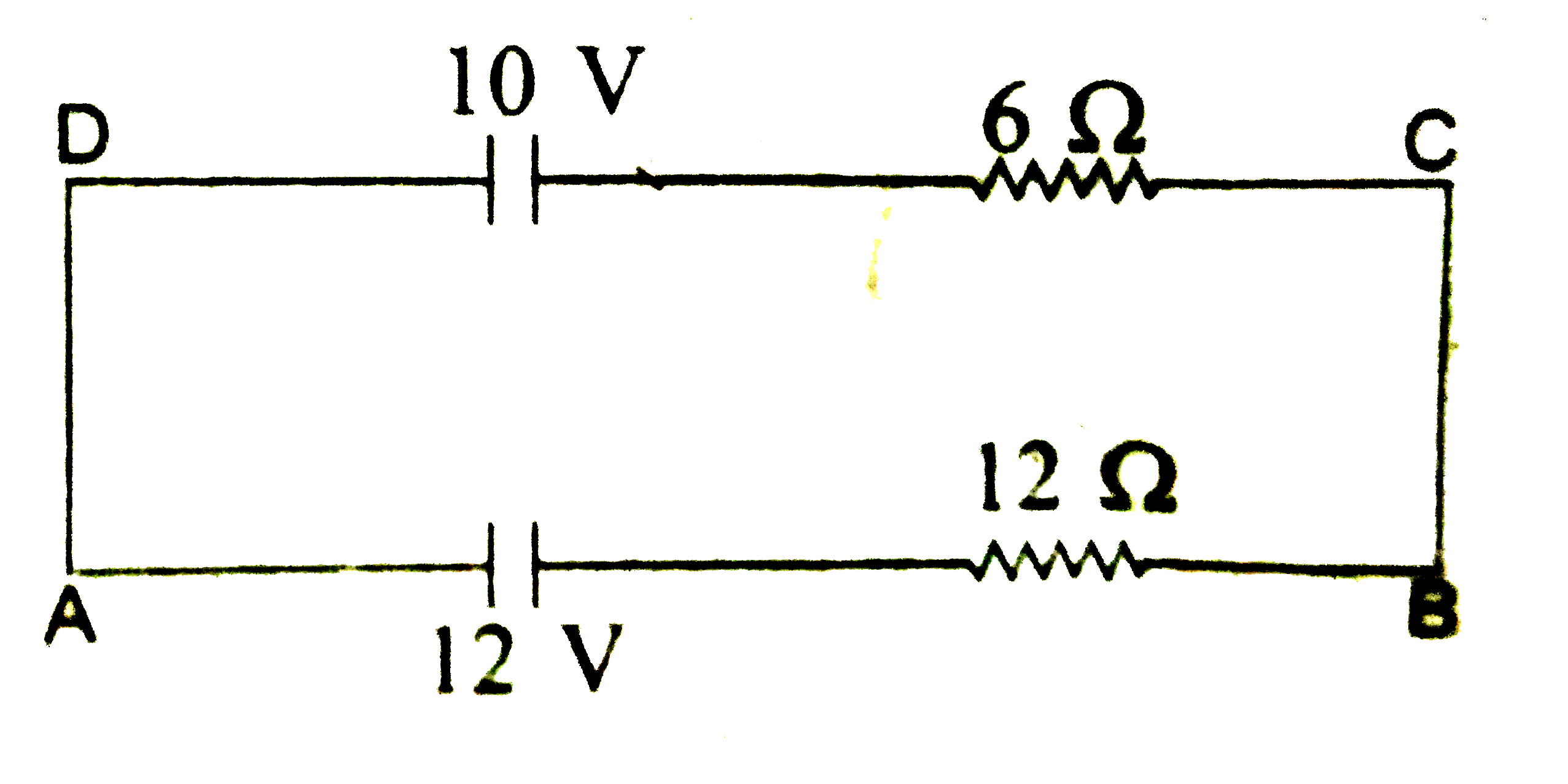An arrangement machine, when given an i line of numbers, rearranges them following a particular rule in each step The following is the illustration of the input and the steps of arrangement
Input: 37, 29, 17, 51, 46, 22, 71, 33
Step I: 71, 29, 17, 51, 46, 22, 37, 33
Step II: 71, 37, 17, 51, 46, 22, 29, 33
Step III: 71, 37, 29, 51, 46, 22, 17, 33
Step IV: 71, 37, 29, 46, 51, 22, 17, 33
Step V: 71, 37, 29, 46, 51, 17, 22, 33
Step VI: 71, 37, 29, 46, 51, 17, 33, 22 Since the numbers are already arranged, the machine stop step. Otherwise the machine may carry on its logic until the au fully arranged. Study the logic and answer the questions that follow
Input: 19,59, 23, 36, 60, 75, 71
what will be the 3rd step ?
71,59,23,36,60, 75, 19
71,59,60,36,23,75, 19
71,59,60,75,23,36,19
71,59,75,36, 60,23,19
Study the changes very carefully. What happens? Clearly, it is not
case of simple arrangement in ascending or descending order. Looki the way 51 and 17 are brought together, so also 33 and 22. Multiples of and then multiples of 11. So the clue: something to do with multiples
What really happens is the following: in case of a composite numis the largest factor
(other than the number itself) is taken into account. the case of a prime number, the number itself is considered. In case u are two multiples, the larger multiple is arranged first.
Thus 37 = 37 × 1,29 = 29 × 1,17 = 17 × 1,51 = 17 × 3,46 =23× 22=11 × 2,71 = 71 × 1,33=11× 3. Now, the underlined parts are o numbers and these are arranged in a descending order. That is comes after 29 because the key number for 46 is 23, which is less than 29
Also, when a number is arranged, it interchanges its pos the wrongly-placed number.
Input:19,59,23,36,60,75,71
step I:71,59,23,36,50,75,19
step II:71,59,60,36,23,75,19(59 was already arranged)
step III :71,59,60,75,23,36,19
Topper's Solved these Questions
- INPUT-OUTPUT(..CONTD):ARRANAGEMENTBOOK - M K PANDEYCHAPTER - INPUT-OUTPUT(..CONTD):ARRANAGEMENTEXERCISE - PRACTICE EXERCISE
41 Videos
- INPUT-OUTPUT (….. CONTD.): MISCELLANEOUS BOOK - M K PANDEYCHAPTER - INPUT-OUTPUT (….. CONTD.): MISCELLANEOUS EXERCISE - Practice Exercises
38 Videos
- PROBLEM SOLVINGBOOK - M K PANDEYCHAPTER - PROBLEM SOLVINGEXERCISE - (EXERCISE 20 C)
147 Videos
Similar Questions
An electronic device when fed with the numbers, rearranges them in a following certain rules. The following is a step-by-step prorement for the given input of numbers.
Input :85, 16, 36,04, 19,97, 63, 09
step I:97, 85, 16, 36, 04, 19, 63, 09
step II:97, 85, 63, 16 ,36, 04, 19, 09
step III:97,85, 63, 36 ,16, 04, 19, 09
step IV:97, 85, 63, 36, 19, 16, 04 ,09
step V:97, 85, 63, 36 ,19, 16 ,09 ,04
(For the given input, step V is the last step.)
Which of the following will be Step V for the given input? Input: 25 08 35 11 88 67 23
View SolutionA number arrangement machine, when given particular input, rearranges it following a particular rule. The following is illustration of the input and the steps of arrangement:

What will be the 4th step of the following input?
Input: 23, 61, 15, 35, 54,75, 85
View SolutionIn a question paper, there are 12 questions in all out of which only six are to be answered. Six questions have an alternative each. Each question has four parts: How many questions including parts are there in the question paper?
View Solutionफारफोरस के निम्नलिखित ऑक्सी अम्ल, के संरचना सूत्र लिखिए - (i) हाइपोफ़ॉस्फ़ोरिक अम्ल (ii) फॉस्फोरिक अम्ल , (iii) ऑर्थोफ़ॉस्फ़ोरिक अम्ल , (iv) पायरोफॉस्फोरिक अम्ल
View Solutionदिए गये विघुत परिपथ की सहायता से ज्ञात कीजिए
- (i) परिपथ में धारा , तथा
(ii) बिन्दु A तथा B के बीच विभवान्तर ।

View Solutionएक प्रेरक के बहने वाली धारा, i=4+12t द्वारा दी जाती है, जहाँ I ऐम्पियर में तथा t सेकण्ड में है | इसमें स्वप्रेरित विधुत वाहक बल 12 mV है | ज्ञात कीजिए- (i) स्वप्रेरकत्व, तथा (ii) t=1 सेकण्ड पर प्रेरक में संचित ऊर्जा एवं इसको प्रदान की गयी शक्ति |
View Solutionदिये गये चित्र में एक LCR परिपथ दिखाया गया है एक प्रत्यावर्ती धारा स्त्रोत वोल्टता V=100sin500t परिपथ से जुड़ा है परिपथ के लिए गणना कीजिए -(i ) प्रतिबाधा (ii ) शक्ति गुणांक ।(iii ) धारा का शिखर मान ।
View Solutiona और b के लिये हल कौजिए :
2a+3b=17 और 2a+2−3b+1=5
View Solution5 पेंसिल तथा 7 कलमों का कुल मूल्य 50 है , जबकि 7 पेंसिल तथा 5 कलमों का कुल मूल्य 46 है । एक पेंसिल का मूल्य ज्ञात कीजिए ।
View Solutionअनुपातों a1a2,b1b2 और c1c2 की तुलना कर ज्ञात कीजिए कि निम्न रेखिक समीकरणो के युग्म सगत है या असगत :
5x−3y=11,−10x+6y=−22
View Solutionएक रेखिक समीकरण दी गई है । दो चरो में एक ऐसी और रेखिक समीकरण लिखिए ताकि प्राप्त युग्म का ज्यामितीय निरूपण जैसा कि:
(i)प्रतिच्छेद करती रेखाए हो।
(ii) समान्तर रेखाए हो।
(iii) सम्पती रेखाए हो|
View Solutionत्रिकोणमितीय सारणी के प्रयोग के बिना मान ज्ञात करो :
sec39∘cosec51∘+2√3tan17∘tan38∘tan60∘tan52∘tan73∘−3(sin231∘+sin259∘)
View Solutionsin229∘+sin261∘=
View Solutionयूरिया के एक जलीय विलयन का हमांक −0.52∘C है. 37∘C पर इस विलयन का परासरण दाब ज्ञात कीजिए .(विलयन की मोलरता एव मोललता समान मान सकते है .) (जल का हिमांक अवनमन स्थिरांक Kf=1.86)
View Solution171 ग्राम शक्कर को (C12H22O11) एक लीटर जल में घोला गया है. घोल की मोलरता है-
View Solutionनिम्नलिखित में संरचना बनाइए-
(i)XeF4(ii)HCIO3,(iii)XeOF4
View Solution
